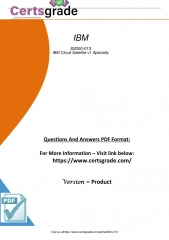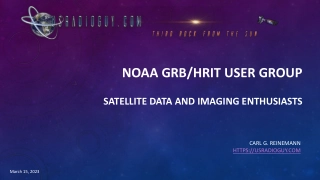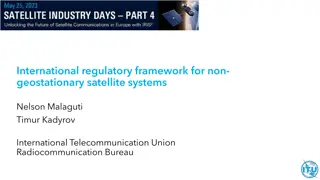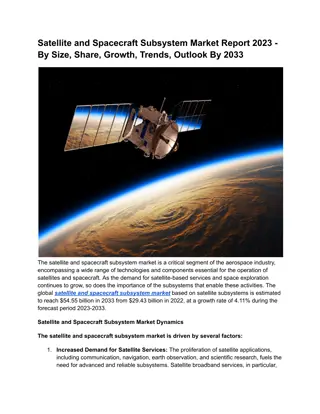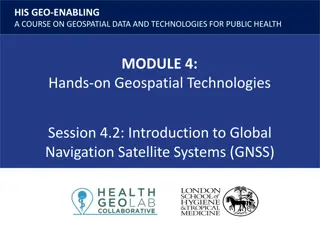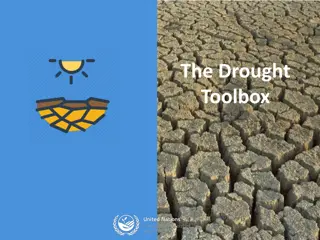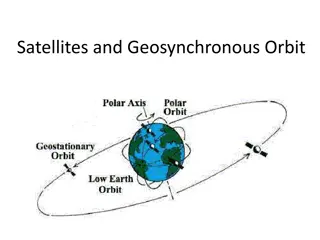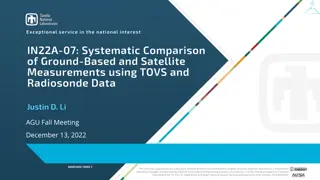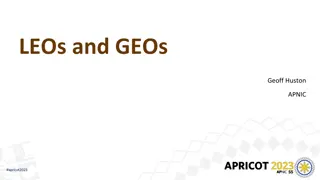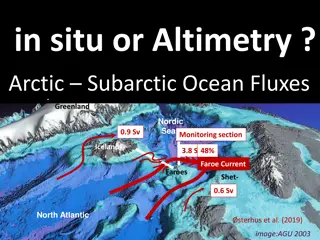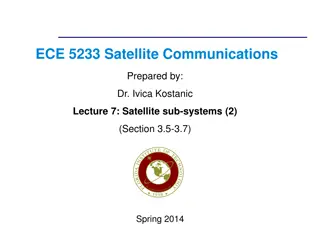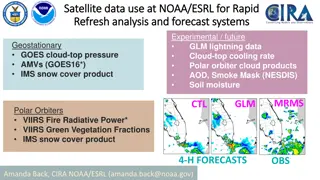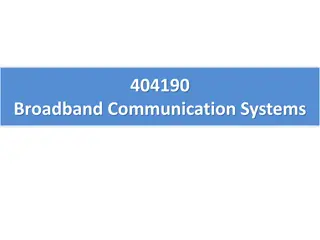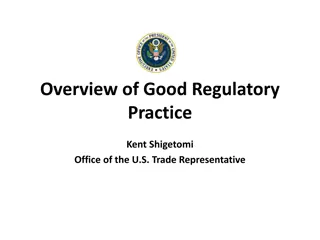Policy and Regulatory Guidelines for Satellite Services
National spectrum management involves governments controlling radio use within their jurisdiction through agencies known as administrations. The International Telecommunication Union (ITU) serves as a global forum for spectrum consultation. Policy-making bodies such as the Federal Communications Commission (FCC) in the United States play crucial roles in satellite communications regulation. Various National Regulation Agencies (NRAs) in Africa oversee satellite communication guidelines and standards.
Download Presentation

Please find below an Image/Link to download the presentation.
The content on the website is provided AS IS for your information and personal use only. It may not be sold, licensed, or shared on other websites without obtaining consent from the author.If you encounter any issues during the download, it is possible that the publisher has removed the file from their server.
You are allowed to download the files provided on this website for personal or commercial use, subject to the condition that they are used lawfully. All files are the property of their respective owners.
The content on the website is provided AS IS for your information and personal use only. It may not be sold, licensed, or shared on other websites without obtaining consent from the author.
E N D
Presentation Transcript
Session 2 POLICY AND REGULATORY GUIDELINES FOR SATELLITE SERVICES 1
1- Radio regulation organizations National spectrum management Governments control the use made of radio by stations within their jurisdiction, typically by making spectrum management a function of a civil service department or by setting up an agency for the purpose. These national regulating bodies are known as administrations . A key function in spectrum management is the assignment of carrier frequencies to transmitting and receiving stations, to be used for approved purposes and within stated parameters. In making these assignments, an administration aims to enable radio operating organizations to achieve their objectives without suffering or causing interference while using the spectrum efficiently, so that subsequent applicants will also be able to get access to the radio medium. When it is necessary to take account of cross- frontier interference liabilities, these administrations collaborate with equivalent agencies in neighbouring countries. 2
1- Radio regulation organizations ITU Where good use of the spectrum requires wider consultation or agreement to permanent policies and procedures, the administrations use the International Telecommunication Union (ITU) as their global forum. Main decisions on policies and procedures are made at periodical World Radiocommunication Conferences (WRCs), held under the aegis of the ITU. These conferences were called World Administrative Radio Conferences (WARCs) prior to 1993. The ITU Rudio Regulations (RR) [l] bring together the decisions of past WRCs and WARCs, with any subsequent amendments. A major revision of the RR was agreed at WRC-95. ITU Radio Regulations (RR) bring together the decisions of past WRCs, with any subsequent amendments. A major revision of the RR was agreed at WRC- 95. 3
1- Radio regulation organizations Policy Making bodies on Satellite communications Federal Communications Commission (FCC) The Federal Communications Commission (FCC) is an independent agency of the United States government, created, directed and empowered by Congressional statute , and with the majority of its commissioners appointed by the current President. The FCC works towards six goals in the areas of : Broadband Competition The spectrum The media Public safety and homeland security And modernizing the FCC. 4
1- Radio regulation organizations Policy Making bodies on Satellite communications National Regulation Agencies (NRAs) in Africa: Eastern and Southern Africa Uganda www.ucc.co.ug Kenya www.cak.go.ke Tanzania http://www.tcra.go.tz Burundi www.arct.gov.bi Sudan http://www.ntc.org.sd Rwanda www.rura.gov.rw Ethiopia http://www.telecom.net.et/ Southern Africa Botswana http://www.bta.org.bw/ Lesotho http://www.lta.org.ls/ Malawi http://www.macra.org.mw/ Mozambique http://www.incm.gov.mz/ Namibia http://www.ncc.org.na/ South Africa http://www.icasa.org.za/ Zambia http://lirne.net/test/ Swaziland http://www.swazi.net/ Angola http://www.inacom.og.ao/ Madagascar http://www.omert.mg/ Mauritius http://www.icta.mu/ / 5
1- Radio regulation organizations Policy Making bodies on Satellite communications National Regulation Agencies (NRAs) in Africa West Africa Nigeria Burkinafaso Cote'd'voire Ghana Senegal Togo Siera Leone Niger Mali Liberia Guinea Benin Gambia www.ncc.gov.ng http://www.artel.bf/ http://www.atci.ci/ http://www.nca.gov.gh/ http://www.artp-senegal.org/ http://www.artp.tg/ http://www.natcom.sl/ (under construction) http://www.arm-niger.org http://mali-reforme-telecom.mctmtl.com/ http://www.lta.org.lr/index.php (under construction) Bissau http://www.icgb.org/ http://www.haacbenin.org/ http://www.pura.gm 6
1- Radio regulation organizations Policy Making bodies on Satellite communications National Regulation Agencies (NRAs) in Africa Northern Africa Algeria Tunisia Egypt Morocco Libya Mauritania Central Africa Chad Democratic Rep. of Congo http://www.arptc.cd/ Congo Equatorial Guinea Gabon Cameroon http://www.arpt.dz/ http://www.intt.tn/ http://www.tra.gov.eg/ http://www.anrt.net.ma/ http://www.gptc-Libya.com (broken link) http://www.are.mr/ http://www.otrt.td/ http://www.dgacpt.com/pages/index.php?idPage=4 http://www.getesa.gq/ http://www.artel.ga/ http://www.art.cm 7
1- Radio regulation organizations Policy Making bodies on Satellite communications ITU The International Telecommunication Union is an agency of the United Nations which regulates information and communication technology issues. As one of the most important organizations regulating telecommunications, the International Telecommunication Union (ITU) has a strong influence on the activities of National Regulatory Authorities (NRA)s. In 2013 ITU has : 193 countries members More than 700 sectors members More than 164associates 8
1- Radio regulation organizations Policy Making bodies on Satellite communications ITU Organization The ITU comprises four sectors, each managing a different aspect of the matters handled by the Union: Radiocommunication (ITU-R) Managing the international radio-frequency spectrum and satellite orbit resources is at the heart of the work of the ITU Radiocommunication Sector (ITU-R). Standardization (ITU-T) ITU's standards-making efforts are its best-known and oldest activity; known prior to 1992 as the International Telephone and Telegraph Consultative Committee or CCITT (from its French name "Comit Consultatif International T l phonique et T l graphique") Development (ITU-D) Established to help spread equitable, sustainable and affordable access to information and communication technologies (ICT). ITU TELECOM organizes events such as exhibitions. A permanent General Secretariat, headed by the Secretary General, manages the day-to-day work of the Union and its sectors. 9
1- Radio regulation organizations Policy Making bodies on Satellite communications Some ITU Mission Specific objectives include: Regulation of satellite communications Coordinate and develop international communications Harmonizing national policies Technical assistance to developing countries in the domain of telecommunications and information access Some ITU Tasks Amongst the tasks assigned to ITU we can mention: Electromagnetic spectrum frequency band allocation Register space orbital position of satellites Control of Radio interferences 10
1- Radio regulation organizations Policy Making bodies on Satellite communications ITSO ITSO is the continuation of INTELSAT, the intergovernmental organization established by treaty in 1973.On July 18, 2001, the satellite fleet, customer contracts and other operational assets were transferred to Intelsat Ltd, a new private company now registered in Luxembourg and various amendments to the ITSO Agreement took effect. Under the ITSO Agreement, as amended , ITSO s primary role was that of supervising and monitoring Intelsat s provision of public telecommunications satellite services as specified in the Public Services Agreement(PSA) entered into between ITSO and Intelsat. In addition, the Director General , on behalf of the Organization, must consider all issues related to the Common Heritage. ITSO currently has 150 Member States. 11
1- Radio regulation organizations Policy Making bodies on Satellite communications ITSO For this purpose, ITSO transferred its global satellite system, including the geostationary-orbital locations, landing rights and the brand-name of Intelsat, to Intelsat, Ltd. Since this transfer in 2001 up to 2010, Intelsat has invested US$ 2.6 billion to substantially improve the global connectivity and coverage that it offers. As a result, Intelsat's global communications network, which was composed of 19 satellites in 2001, has expanded to 53 satellites through new launches and acquisitions, while Intelsat simultaneously has expanded its terrestrial facilities, including teleports, points of presence and fiber connectivity. 12
1- Radio regulation organizations Policy Making bodies on Satellite communications ITSO 13
2- Satellite policy principles Non Discriminatory Market Entry The first prerequisite for an open, competitive market is a legal and regulatory structure that does not discriminate in favour of existing service providers, or otherwise limit the number of independent service providers that are permitted to provide satellite and telecommunications services to consumers. Vigorous competition between a large number of market entrants encourages investment in infrastructure, provision of new services, improvements in quality and availability of lower prices. 14
2- Satellite policy principles Open borders for competitive access The second necessary measure for an open, competitive market is providing nondiscriminatory market access for both domestic and non-domestic satellite and telecommunications service providers. This is often referred to as an Open Skies policy. It is important for countries to eliminate regulations that, although not discriminatory on their face, may have the unintended effect of preventing access by non domestic service providers. 15
2- Satellite policy principles Open borders for competitive access For example, satellite service operators should not be required to have a corporate presence in a country in order to provide services in that country. Furthermore, if a satellite operator has already received a license for its space segment from its home country and has coordinated the satellite through the ITU, then no duplicate licensing requirement should be imposed on the use of that space segment to provide services in any other country. 16
2- Satellite policy principles Transparency of Telecommunication Rules and Policies Another important principle included in the WTO agreement is the need for countries to employ transparency in telecommunications regulation. In compliance with the WTO Agreement, a significant number of regulators have undertaken the task of publishing regularly their laws and regulations on satellite licensing and permits. Making this information readily available to the public is an extraordinary step in advancing the transparency of a country s policies. 17
2- Satellite policy principles Content neutral regulation Satellite networks can be effectively used to provide all forms of telecommunications services. As a result, administrations that regulate content often apply those regulations to satellite operators. For example, some countries still maintain limits on the number of carriers that are permitted to provide international voice traffic. Other countries restrict the provision of private line resale services, call- back services, or international carriage of Voice over Internet (VoIP) protocol. 18
2- Satellite policy principles Content neutral regulation In any event, content restrictions that are imposed by a country should be technology-neutral applying equally to satellite-based and wireline telecommunications service providers. Since satellite networks can be used to provide all forms of telecommunications services, no country should limit the number of satellite licenses that are issued in an attempt to restrict certain types of content. 19
2- Satellite policy principles Technology-Neutral Regulations and Licensing Requirements Modern telecommunications services are being provided to consumers using a number of different technologies, such as wireline, satellite and terrestrial wireless networks. In order to facilitate fair competition between these technologies, regulators must strive, to the extent possible, to make their regulations, licensing requirements and regulatory fees technically neutral. In order to ensure that regulations are technology-neutral, regulators should strictly limit their regulations and licensing requirements for satellite services, using them solely to (1) protect the public safety and (2) manage scarce public resources, such as frequency spectrum when there is more than a negligible risk of harmful interference. 20
3- Legal framework Legal framework United Nations Outer Space Treaty (1967) Outer space free for exploitation and use by all states in conformity with international regulations States retain jurisdiction and control over objects they have launched into outer space 21
3- Legal framework Legal framework United Nations Outer Space Treaty (1967) International Telecommunication Union Allocation of frequency bands Instruments (CS, CV, RR, RoPs, Recs) Procedures, Plans, operational measures 22
4- Key regulatory and licensing trends The public policy principles discussed above provide a clear road map for administrations seeking to establish a licensing and regulatory structure for satellite services, or to reform existing regulatory structure in order to facilitate competition. Non-discriminatory licensing requirements provide a country with a useful tool to ensure safety and keep up to date with technology developments and demands. Licensing requirements and their associated costs vary worldwide, but a significant trend has emerged toward adopting more streamlined, publicly accessible licensing arrangements for satellite network operators and service providers. This trend reflects the fact that as discussed above licensing of satellite services should be used solely for two purposes to protect public safety and to manage spectrum resources in order to prevent unreasonable interference. 23
4- Key regulatory and licensing trends Space segment (Spectrum Management and Licensing) Radio Regulations Lengthy & complex procedure Decided by Administrations during WRC Governed by: More sophisticated use of spectrum Individual requirements of administrations Trend towards simplification /improvement to certain procedures 24
4- Key regulatory and licensing trends Space segment (Spectrum Management and Licensing) Rights & obligations + applicable procedures Two mechanisms of sharing orbit /spectrum: Coordination Approach Planning Approach Efficiency First come, first served for actual requirements Equitable access Plan for future use 25
4- Key regulatory and licensing trends Space segment (Spectrum Management and Licensing) First Come, First Served Procedure Rights acquired through coordination with administrations concerning actual usage Efficient spectrum / orbit management Dense/irregular orbital distribution of space stations Continuing responsibility for the networks Plan Procedure Congestion of the GSO Frequency / orbital position plans Guarantee for equitable access to the spectrum / orbital resources Spectrum set aside for future use by all countries Predetermined orbital position & frequency spectrum 26
4- Key regulatory and licensing trends World Radio Communicatons Summit 2012 outcomes WRC 2012 World Radiocommunication Conferences (WRC) are held every three to four years. ITSO Participated at the World Radiocommunication Conference (WRC-12), 23 January 2012 to 17 February 2012, Geneva, Switzerland Under the terms of the ITU Constitution, a WRC can: revise the Radio Regulations and any associated Frequency assignment and allotment Plans; address any radiocommunication matter of worldwide character; instruct the Radio Regulations Board and the Radiocommunication Bureau, and review their activities; determine Questions for study by the Radiocommunication Assembly and its Study Groups in preparation for future Radiocommunication Conferences. 27
4- Key regulatory and licensing trends Ground segment In addition to licensing of the space segment, many administrations have attempted to create licensing regimes for the terrestrial segment of satellite networks. Efforts to require licenses for the ground segment can be divided into two groups : - authorization requirements for satellite service providers - and individual licensing for earth station facilities. Both approaches are discussed below. 28
4- Key regulatory and licensing trends Ground segment (Network Operator and Service Provider Licensing) Many countries require that public network operators hold licenses so that there is some quality assurance of the service being provided to their public. A few countries have adopted this rule also for private VSAT services. As the nature of private satellite services is being understood better, the requirement for this type of license is declining. These types of licenses can also be referred to as Service Provider Licenses, Value Added Service Licenses and sometimes certain types of Class Licenses. 29
4- Key regulatory and licensing trends Ground segment (Individual and Blanket Earth Station Licensing) Traditionally, most governments have required each VSAT or mobile terminal to be licensed individually; this was in addition to requiring a network operator s license. But more than 10 years ago, a new approach to regulating VSATs - blanket licensing began to be implemented and it has been successful. With this regulation, VSATs are configured based upon technical criteria involving power level, frequency, etc. - that eliminate the risk of unreasonable interference. Thus, a single blanket license can be issued covering a very large number of VSAT terminals. 30
4- Key regulatory and licensing trends Ground segment (Individual and Blanket Earth Station Licensing) EARTH STATION AND VSAT REGISTRATION The ITU controls frequency allocations, permitted power levels and modes of operation. These restrictions are intended primarily to prevent interference between all types of systems employing radio communications and to protect some telecommunications services, such as emergency services. In addition to that, many governments currently impose restrictions and regulations on service providers and users. These national regulations are specific to each particular country. 31
4- Key regulatory and licensing trends Ground segment (Individual and Blanket Earth Station Licensing) EARTH STATION AND VSAT REGISTRATION Due to the increasing uptake of sophisticated telecommunications systems, that are sold and used in all countries, the licensing regime for end-user equipment (such as VSAT terminals) is becoming simpler and less costly. You will find the procedures and regulations that rule the installation and operation of VSAT terminals at regulations agencies in the countries or on ITU web site. 32
4- Key regulatory and licensing trends Ground segment (Individual and Blanket Earth Station Licensing) EARTH STATION AND VSAT REGISTRATION A licence is required by the national telecommunications authority of a country where any earth station as a part of a network, be it the hub, a control station or a VSAT, is planned to be installed and operated. The concern reflected here is to ensure compatibility between radio networks by avoiding harmful interference between different systems. By doing so, any licensed operator within a certain frequency band is recognized as not causing unacceptable interference to others, and is protected from interference caused by others. In the past, national telecommunication authorities have required licensing of individual VSAT terminals in addition to requiring a network operator s license. Then, the US Federal Communication Commission (FCC) implemented with success a blanket licensing approach for VSATs operated within the US. 33
4- Key regulatory and licensing trends Ground segment (Individual and Blanket Earth Station Licensing) EARTH STATION AND VSAT REGISTRATION With blanket licensing, VSATs are configured based upon technical criteria (power level, frequency, etc.) to eliminate the risk of interference, so a single license can be issued covering a large number of VSAT terminals. Blanket licensing has since gained interest among national telecommunications authorities all over the world, as a result of equipment manufacturers complying with the recommendations issued by international standardization bodies, such as the International Telecommunication Union (ITU) and the European Telecommunications Standard Institute (ETSI). Relevant documentation from these bodies is available at http://www.itu.int/home/index.html and http://www.etsi.org/. 34
4- Key regulatory and licensing trends Ground segment (Individual and Blanket Earth Station Licensing) EARTH STATION AND VSAT REGISTRATION A licence usually entails the payment of a licence fee, which is most often in two parts: a one-time fee for the licensing work and an annual charge per station. The licensing procedure is simpler when the network is national, as only one telecom authority is involved. For transborder networks, licences must be obtained from the different national authorities where the relevant earth stations are planned to be installed and operated, and rules often differ from one country to another. To facilitate the access to these rules, telecommunications authorities around the world have began posting data related to their nations VSAT regulatory conditions on the World Wide Web. 35
4- Key regulatory and licensing trends Establishing appriopriate fees The fundamental rationale for licensing fees is that they should compensate administrative costs to the regulator but should not be used as a source of real profit for the government. In addition to publicising rules regarding satellite licensing, fee structures should be clearly defined for the public without discrimination. Companies assess expected costs before market entry, so clarity and availability of this information is critical. 36
5- Means of monitoring and controlling the spectrum In granting radio frequencies, the authority or agency verifies the applicants planned location of radio equipment before installation and checks the authorized equipment for conformity with the licensing conditions. Theagencycarries out pre-license and post license conformity inspections with the aim to control the frequency usage consequently to detect any illegal (unlicensed) usage of the spectrum. 37
5- Means of monitoring and controlling the spectrum The Main tasks of the regulation agency will typically consist of : Verify applicant s planned location of radio equipment before installation. Check the authorized equipment for conformity with the licensing conditions. Carry out conformity inspection prior to and after granting licences Carry out random checking on installations to verify compliance to assigned specifications as well as the real condition of equipment declared to be unused. Survey and inspect radio communication installations. Ensure compliance of equipment and stations with he national rules and regulations. 38
5- Means of monitoring and controlling the spectrum Check the frequency spectrum, in relation to enforcement and monitoring aspects. Ensure compliance with national conditions of licenses. Check the technical and operational characteristics of radio equipment. Verify the compatibility and the interference-free use of authorized emissions, to detect and identify the origin of interference and to resolve them. Detect and identify unauthorized transmissions. Determine channel and band usage, including assessment of channel availability. Assist to resolve interference problems 39
5- Means of monitoring and controlling the spectrum The interferences and signal strengths can be measured using a measurement vehicle. 40
End of Session 2 POLICY AND REGULATORY GUIDELINES FOR SATELLITE SERVICES 41



